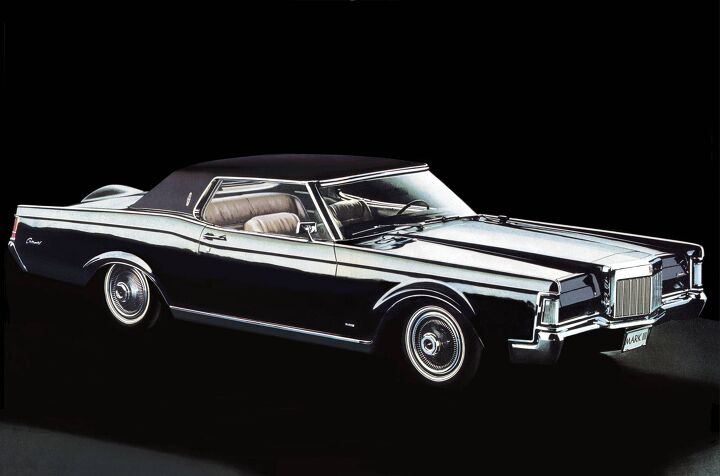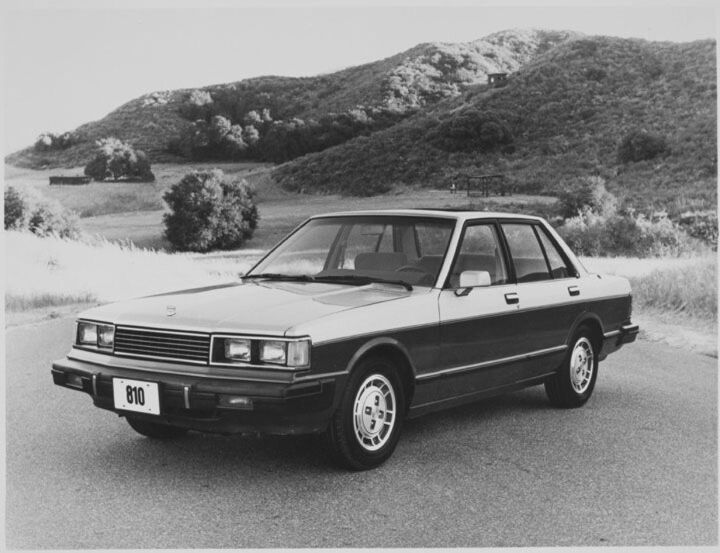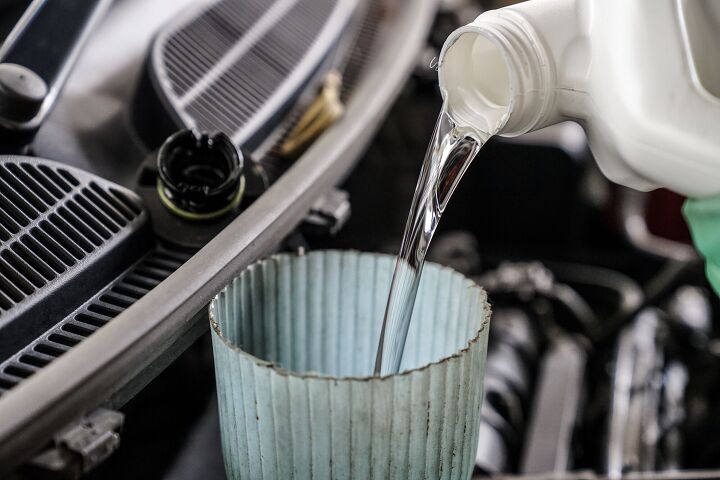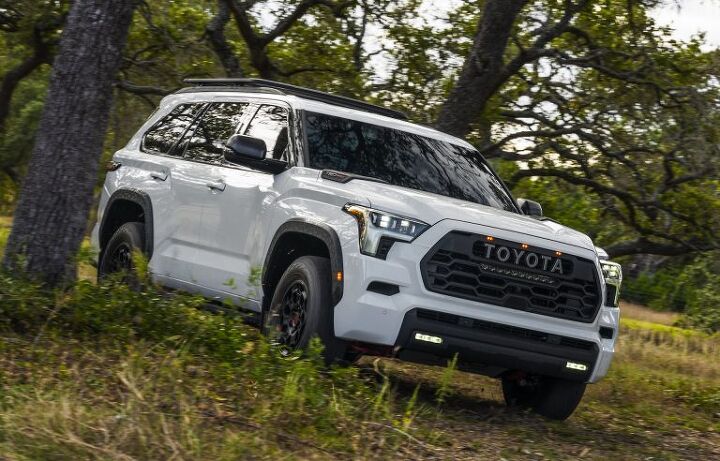Rare Rides Icons: The History of Stutz, Stop and Go Fast (Part XIX)
Today we find ourselves in the 19th chapter of Stutz historical coverage. In the early Eighties Stutz (somewhat) successfully branched out from its Blackhawk-only product line, and made the Bearcat targa, the Bearcat II convertible, some SUVs for dictatorial armament and parade usage, as well as sedans and limousines.
We’re in the latter group of automobiles at the moment. So far we’ve covered the one-off Duplex that found no customers, and its successor the IV-Porte that did. After the IV-Porte came the Victoria, which added 10 additional inches to IV-Porte’s base, the B-body Bonneville. Victoria survived the Bonneville’s full-size demise in 1981 and moved its basis to the similar Oldsmobile 88 in 1982. Around that time Stutz added an even more exclusive, larger, and more garish sedan to the lineup. Let’s talk about Diplomatica.
Rare Rides Icons: The Lincoln Mark Series Cars, Feeling Continental (Part XII)
Lincoln was in a bad way at the turn of the Sixties, both financially and in terms of its product. The company lost hundreds of millions (adjusted) in the early and middle portion of the decade, when it invested in and then promptly canceled the Continental Division. Attempting a rebound, Lincoln dumped lots more cash into a new unibody platform that was exclusive to Lincoln models.
The new lineup was on sale from 1958 to 1960 and was unfortunately introduced at the start of a sharp economic recession. However, even after the recession ended Lincoln’s gaudy and overworked styling caused customers to steer clear of Lincoln and purchase Cadillacs instead. Lincoln lost $60 million ($550 million adj.) more.
1961 heralded the arrival of an all-Continental lineup, the Elwood Engel design that was instantly popular and saved the company. However, the new and streamlined (in all ways) Lincoln lineup spared no room for a Continental Mark series. The Mark slumbered until 1968.
Rare Rides Icons, The Nissan Maxima Story (Part II)
Abandoned History: The Life and Times of Edsel, a Ford Alternative by Ford (Part IV)
In our last edition of Abandoned History, we found ourselves in the earliest days of Edsel sales in 1958. The new company offered a full lineup of four sedan-based models and three different wagons. But because Edsel failed so spectacularly, 1958 was the only year it had a broad product offering. Four of seven models were eliminated before the company’s second model year.
Last time we covered the cheapest of the one-offs, the Pacer. Its near entry-level status confused customers as it wasn’t exactly a cheap vehicle at $2,700 ($27,973 adj.) before options like a heater or radio. Pacer was also based on a Ford, but priced more like a Mercury. Still, the Pacer found 19,057 customers in its only year; many more than the upmarket Citation found during its outing.
Rare Rides Icons: The History of Kia's Larger and Full-size Sedans (Part XI)
Kia’s second attempt at a K7 (Cadenza in North America) arrived at a time when the company fully embraced a styling language of its own. More upscale and nicer to look at than the derivative generation of 2010 to 2016, the new Cadenza debuted in all global markets for 2017. Kia was hopeful the second Cadenza would sell better than the first one, particularly in North America. Any predictions on how that went?
Rare Rides Personas: Powel Crosley Junior, Tiny Cars, Radio, and Baseball (Part II)
We return today to our coverage of the life and times of Powel Crosley Junior, the first subject in our new Rare Rides Personas series. Born in Cincinnati in 1886, Crosley was the son of a lawyer and the eldest of four. From an early age, he showed adeptness at engineering and technology but lacked an interest in the classroom learning behind it.
He and his brother Lewis built their first car - an EV wagon - at ages 12 and 10 to win a bet with their father. It was the first of many car ventures for Crosley, who was completely fascinated with the up-and-coming automobile. By age 21 he was raising funds to start a car company.
Rare Rides Icons: Lamborghini's Front-Engine Grand Touring Coupes (Part VII)
When we last left Lamborghini’s front-engine coupe timeline, Ferruccio Lamborghini found himself about out of time to designate a replacement for the 400GT 2+2. Touring’s Flying Star II two-seat shooting brake was radical and possessed neither the restrained GT styling Mr. Lamborghini desired, nor the full four-place capacity. The company turned to Bertone and design legend Marcelo Gandini, who proposed the four-seat Marzal.
The Marzal’s design was as radical as the Flying Star if not more, and had gullwing doors and an interior filled with silver textile. After it debuted Ferruccio remarked how the Marzal was just a fun design exercise and was not intended to be a production car. Whether that statement was actually true remains unclear, but seems unlikely given the events that occurred post-Marzal. Lamborghini needed a real production design, and fast.
Rare Rides Icons, The Nissan Maxima Story (Part I)
With the recent and not surprising news of the Nissan Maxima’s planned demise in 2023, it’s time for a Rare Rides retrospective on a nameplate that was once lauded as one of the best sporty sedans on the market. From its origins as a rear-drive Datsun to the eighth generation that’s a shadow of its former self, the Maxima persisted with its unique value proposition: That it was a step up from the standard Japanese family sedan. Our story begins in Japan, with the Bluebird range.
Rare Rides Icons: The Lincoln Mark Series Cars, Feeling Continental (Part XI)
We resume our Mark series coverage in the 1960 model year, which happened to be a last-of for several reasons. It was the last of the unibody Lincoln lineup that debuted in 1958, the Continental Mark line of models, and for Lincoln’s model naming scheme as a whole. We covered the visual edits in our last entry; a return to some of the garishness of 1958 that Elwood Engel tried to tone down in 1959. With the additional gingerbread hanging off of every possible surface of the Mark V Continentals for 1960, the lineup grew larger in every direction and heavier than ever before.
Rare Rides: The 1996 Toyota Classic, Truck-based Throwback
Today’s Rare Ride is brought to you by a Tweet that featured today’s subject and was the exact moment your author became aware of its existence. Released in the Nineties prior to the American retro styling craze, the Classic was a limited edition sedan sold only to Japanese customers. Curious yet?
TTAC's Next Podcast: Chatting Cars With Robby DeGraff
The TTAC podcast is back, and we were aggressively Midwest this time around.
Best Garage Work Lights: Bright Stuff
It’s a safe bet that most DIYers are grateful to the wrenching deities for the democratization of LED illumination – especially when talking about work lights. Your author used to toil under cars and in tight spaces with incandescent work lights that heated themselves to approximately the surface of the sun, as I’m sure you all did as well.
Best Socket Sets: Sock It To Ya
We’ve covered mechanic’s sets in the past but, in this updated post, we are going to focus on dedicated socket sets. That means no sets with piece-count padders like Allen keys in an obscure size or that one tool that only serves to remove the Färhfvingenator on your clapped-out Volkswagen.
Best Tail Light Bulbs: Get the Dim Out
Scattered amongst all the commerce posts you’ve read on this and other sites about ZOMG PRIME DAY DEALS featuring a wide array of products are lists like this one, focused on a single type of car part that you’re not likely to think about until its actually needed.
Best Oil Drain Pans: Greasy Situation
If you followed our advice about socket sets and garage door openers, you’re well on your way to dabbling in a bit of automotive DIY. A good place to start? The simple oil change. Since oil is the lifeblood of your car, it’s an excellent idea to understand why it’s important to change it regularly.
Lightning Strikes the TTAC Podcast
The TTAC podcast is back! In our fourth episode, we talk Ford Lightning, Kia Sportage, Formula One in Miami, and the best cars from 2007.
Best Radiator Flushes: Feeling Flushed
There’s solid evidence in the comment section of this august publication that we (the collective we, which includes readers and authors) have held the keys to a horrible car or two at some point in their automotive career. A quick headcount in the official TTAC Slack chat reveals humans with a propensity to own decrepit Miata convertibles and Lincoln coupes alike.
Best Spark Plug Sockets: The Gappening
Continuing the recent trend of DIY tools, we’ve selected spark plug sockets as today’s list of choices. While not all of us set gaps and fiddle with old fashioned points systems, there’s a solid chance most of our readers have had cause to throw a new set of plugs in their beater at some point or another.
Best Racing Seats: Have a Seat
It is freely admitted a bit of help was enlisted for this post. After all, your author does not generally purchase items for his daily driver that intentionally make it less comfortable, except for the U-Cheap-OutTM suspension kit he once purchased (best to gloss over that one).
Best Oil Filters: Engine Protections
There are some things best enjoyed without filters – Instagram photos, discussions about pay with your boss, and those Camel cigarettes from the ’80s. What definitely does require a filter is the oiling system on your car’s engine. We’ve gathered a few of them here.
Best Cordless Drills: You Know the Drill
There will be a few in our readership who are going to immediately point out that cordless drills aren’t strictly an automotive tool or accessory. And, for once, they’re technically correct. The first genre one generally thinks of when an ad for cordless drills appears is the construction industry. An maybe the props department for a science-fiction B-movie.
Cargo Ship Goes Down With Hold Full of German Automobiles
After two weeks of smoldering in the Atlantic Ocean, a cargo ship loaded with several thousand German automobiles has sunk. Packed with over 4,000 vehicles from Volkswagen Group, the Felicity Ace (pictured) originally gained notoriety for being a successful fire rescue mission conducted in open waters. But it was later revealed that a large number of the cars onboard were higher-end products from brands like Audi, Porsche, Bentley, and Lamborghini — making the salvage operation that followed likewise engaging.
Due to the immense size of the Felicity Ace, it would need to be towed several hundred nautical miles back toward Portugal so it could be serviced. Crews reportedly arrived on February 25th to evaluate the ship and prepare it for the trip back East. However, the cargo vessel began listing until it started to fall onto its starboard side and is now deemed unsalvageable. It’s assumed that the craft will be sinking near its current position, roughly 220 nautical miles from off the Portuguese Azores, taking its vehicular cargo along for the ride.
Best Brake Caliper Paints: Them's the Brakes
For those of us unable or unwilling to make monthly payments to an OEM overlord, preventing us from ordering a car exactly as we’d like it from the factory, turning to the aftermarket sates our desire for owning a vehicle that’s a bit different than all the others that left the factory. Beats turning to illicit substances, I suppose.
Best Options for Garage Shelving: Leader of the Pack Rat
There’s a general understanding amongst gearheads that no matter how big one’s garage or storage space, it’ll eventually fill up. A two car garage will be just as full as a single, while that 40’ x 40′ unit your neighbor is building will be filled to capacity by year’s end. It’s just the natural order of things.
Junkyard Find: 1991 Toyota Corolla Wagon With 315,406 Miles
Best Engine Flushes: Feeling Flushed
We’ll preface this post with the admonition that, unless you’re reasonably familiar with the environs of an engine bay, you should keep your paws off stuff like this. However, a case can be made that anyone who’s fleet is comprised of machines that actually need these products is probably intimately familiar with the contents of a rusty toolbox.
Reading the Riot Act: GM Pens Memo to Dealers About Markups
It has been a seller’s market over the last few months (more than that, if we’re honest) in the car industry, with demand far outstripping supply for most vehicles. Images of dealer lots bereft of vehicles to sell have become familiar. This has led to some stores slapping so-called market adjustments on hot-selling inventory, sure in the knowledge that someone will pay the inflated asking price.
Manufacturers are noticing. Ford chirped about the practice earlier this year, and now GM has seen fit to send its dealers a sternly worded letter as well.
Survey: Which EVs Are Leaving Drivers the Most Satisfied?
With electric vehicles getting a lot of press, you might be wondering which models are scratching consumers in all the right places.
According to J.D. Power’s U.S. Electric Vehicle Experience Ownership Study, the Kia Niro EV is the best thing the mainstream BEV market currently has to offer. The Korean model garnered a satisfaction rating of 744 points out of a possible 1,000. However, it wasn’t the top dog overall. That honor fell to the Tesla Model 3, which achieved a score of 777 points — besting the industry average for premium electrics by a whole seven points.
Toyota Introduces the 2023 Sequoia
Americans like their SUVs – and for some customers, bigger is better. One need look no further than parking lots filled with Tahoes and Grand Wagoneers for confirmation, not to mention their extended-length brethren like the Suburban and upcoming Grand Wagoneer XL.
Toyota has been in this game as well, albeit with an offering older than Methuselah. That changes for 2023, with the introduction of a new Sequoia.
Best Wheel Cleaning Brushes: Wheely Clean
If you tend to skip over our DIY post weeks, perhaps this one will be more to your liking. While not everyone wants or has the space to wrench on their own ride, there’s a solid chance that most gearheads like to have a few cleaning tools on hand.
Rare Rides: The 1958 Buick Limited Lineup, a Very Expensive Roadmaster
Today’s Rare Ride was a single-year offering at Buick; it came and went in 1958. As General Motors reworked its large car offerings that year in response to styling changes at one of its biggest competitors, it reintroduced a historical nameplate at Buick: Limited.
Junkyard Find: 2005 Chrysler Crossfire Limited Roadster
Best Antifreeze: That's Cool
Maintaining your out-of-warranty ride often forces us to learn the different systems in our vehicles. After wrenching on them for interminable amounts of time, knowing the ins and outs of the braking system or suspension bits is kind of inevitable.
Cadillac Introduces Escalade V
Well, that didn’t take long. Mere minutes after our post this morning about the upcoming Cadillac Escalade V, the brand dropped official images of the thing – much earlier in the day than expected. But if you think TTAC had anything to do with that decision, we’ve some bridges in which you may be interested. After all, no one at RenCen reads TTAC, right? Right? (*nudge, nudge, wink, wink*)
As for the upcoming Escalade V, it promises to be a ground shaker.
Best Mechanic's Gloves: Fits Like A …
Quick – what’s the first thing you reach for when starting any DIY project? No, it isn’t the perpetually absent 10mm socket, nor is it a quarter for the swear jar. It is, most likely a good pair of gloves.
Stellantis CEO Says Electrification Advanced by Politicians, Not the Industry
Despite Stellantis making formal announcements that it will be investing 30 billion euros ($34 billion USD) into its novel electrification strategy, CEO Carlos Tavares has been making it sound as if the automaker’s plan was crafted under duress. He’s been telling European media that the widespread adoption of EVs is primarily being pushed by politicians who are ignoring the environmental risks and logistical shortcomings.
“What is clear is that electrification is a technology chosen by politicians, not the industry,” he said told the press this week.
Abandoned History: General Motors' High Technology Engine, and Other CAFE Foibles (Part I)
A modern and efficient V8 of 4.1 liters, the HT4100 was the exciting way forward for Cadillac’s propulsion needs in the early Eighties. The engine came hot on the tail of a very iffy cylinder deactivation experiment, V8-6-4. Unfortunately, just like the cylinder games before and the Northstar after, the HT was plagued with issues that took years to iron out. The HT in its name meant High Technology but could’ve meant Halfway There. Let’s travel back to the Seventies and talk cylinders.
Lincoln Now Sells More Product in China Than U.S.
After years of Ford unsuccessfully trying to court the Chinese market in the same way General Motors did, Blue Oval has finally hit an important milestone. For the first time ever, the Lincoln luxury brand has achieved more sales in China than in the United States.
On Thursday, Lincoln announced that it had delivered more than 91,000 vehicles in China in 2021 – representing an increase of 48 percent increase against 2020. Meanwhile, the brand managed to lose ground in North America with just 86,929 sales for last year. That’s the worst Lincoln has seen in over a decade, though the company has basically witnessed its share of the U.S. market seesawing in the wrong direction since the 1990s.
Rare Rides Icons: The History of Imperial, More Than Just a Car (Part XII)
As we make our way into the 12th installment of Rare Rides Icon’s Imperial coverage, the third generation 1967 Imperial became the shortest-lived in the nameplate’s history. After the decade-long reign of the D-body, Imperial switched to the unibody C platform to cut costs, and move on from dated body-on-frame underpinnings. But it was an odd time to introduce a new car, as the C-body was no spring chicken when the Imperial debuted. More importantly, Chrysler was on the cusp of an entirely new styling direction: The Fuselage Look.
2022 Cadillac CT5-V Blackwing Review - That Rare Moment When Everything Clicks
Back in 2016, I had plenty of nice things to say about Cadillac’s flagship performance model of the day, the third-generation CTS-V. But while Cadillac’s naming conventions have become much more convoluted over the past six years, on paper the CT5-V Blackwing seems like more of the same: A big, boosted V8 still remains under the hood, and it’s still underpinned by an updated version of GM’s Alpha platform. The interior still isn’t on par with its German rivals, and because it’s still rear-wheel drive, it’s still a few ticks behind its all-wheel-drive competition in the sprint to 60 MPH.
Yet despite these objective facts, the CT5-V Blackwing proves to be a stone-cold revelation. Yes, the re-introduction of the six-speed manual transmission plays a significant role in that, but there’s much more going on here than just the availability of a third pedal. Not only has Cadillac addressed virtually all of the shortcomings that held the CTS-V back from venturing into instant-classic territory, they’ve refined and improved the formula in so many subtle ways that the CT5-V Blackwing feels like a totally different car.
2022 Hyundai Tucson Review – For Want of a Knob
Compact crossover land is a funny place. It’s a place where every vehicle is broadly similar, and where the most subtle of differences can distinguish one vehicle from the next. It’s not a world where standing out with something radically different either in styling or engineering will typically yield wins.
Subtle differences certainly show with the 2022 Hyundai Tucson. The styling is a touch different than the rest, with an unusual front lighting setup and interesting character lines throughout. One difference, however, can cause some consternation among some drivers.
Toyota Introduces New Top-Dog Tundra
Builders of half-ton trucks in this nation are perpetually searching the upper limit of what customers are willing to pay for a new rig, with the moneyed set having plenty of choices when looking for a leather-lined and luxurious pickup. For the last few years, Toyota has had the 1794 Edition as an arrow in its quiver to compete against the crew from Detroit. Now, with their recently refurbished pickup truck, they’re going a step further. Meet the Toyota Tundra Capstone.
Junkyard Find: 1990 Pontiac Grand Prix Turbo Coupe
The Pontiac Grand Prix started life as a sporty hardtop coupe version of the full-size 1962 Catalina, then spent the 1969 through 1987 model years as a midsize rear-wheel-drive sibling to the Chevy Monte Carlo. For 1988, the Grand Prix moved to the brand-new front-wheel-drive W platform, immediately winning Motor Trend’s Car of the Year award and carrying on John DeLorean’s tradition of affordable personal luxury cars with a rakish bad-boy-in-a-suit image. Here’s an ultra-rare example of the most expensive Grand Prix available for 1990, found in a Denver-area self-service yard last month.
Junkyard Find: 1988 Cadillac Fleetwood D'Elegance
1988 was an interesting year for The General’s Cadillac Division. The Cavalier-based Cimarron was in its final year of sales, the Hamtramck/Turin-built Allanté was in its second year (and priced about the same as a Mercedes-Benz S-Class), and the “traditional” rear-wheel-drive Brougham sedan shared showroom space with the front-wheel-drive De Villes, Eldorados, and Sevilles. The old Sixty Special name was still being used, along with such slightly newer titles as Elegante and d’Elegance. While the Allanté lived at the top of the GM prestige pyramid for ’88, the Fleetwood was the car of choice for those very wealthy Cadillac shoppers who insisted on four doors and zero Pininfarina nonsense. Here’s one of those cars, found in excellent condition in a Denver yard last spring.
The Best Heated Seat Covers for Your Car
If you live in an area that experiences freezing temperatures in the winter, you can appreciate the effect of the best heated seat covers for your car. Getting into a cold car with cold seats on a 0 degree morning is a harsh way to start the morning. Even if you start the car in advance to let it warm up a bit, the seats often hold in the cold, creating an uncomfortable situation for the early portion of your morning commute.
Best Rust Converters and Removers: Rid the Iron Oxide
Before you get bent out of shape, know that this post isn’t about those infernal gadgets that late-night television tries to sell us. You know the ones – they promise to send an electric charge through the body of a vehicle to allegedly neutralize conditions in which rust normally forms. The less said about those, the better.
The Best Winter Tires for Your Car Truck or SUV
If you live in a region that gets harsh winters, with snow and ice that makes driving a nightmare, you want the best winter tires possible. Whether you drive a car, truck or sport utility vehicle – even one with four-wheel-drive or all-wheel-drive – proper snow tires will allow your vehicle to accelerate, steer and brake more confidently and more safely than an all-season tire.
The Best Radar Detectors
While we wouldn’t suggest you do it, if you are someone who might occasionally drive a little north of the posted speed limit, having one of the best radar detectors available with you could save you some potential problems. The average cost of a speeding ticket in the United States is $150, but the average insurance rate increase for an average speeding ticket is roughly $350, so if you get caught going a little too fast, it could end up costing you up more than $500. And that cost can increase exponentially if it happens more than once in a year.
Opinion: Automakers Are Overstepping Their Boundaries
General Motors now requires salaried employees operating in the United States to disclose their coronavirus vaccination status. As confirmed by the automaker on Thursday, the decision is supposed to help the company determine what percentage of its own workforce is vaccinated so it can make better decisions about which safety protocols to implement. But your author is under the assumption that “as many as possible” will always be the preferred answer.
Earlier in the month, GM forced all salaried employees to disclose whether or not they were immunized for COVID-19 using the automaker’s internal network. Those answering to the affirmative were required to submit proof of vaccination by last Monday. But it sounds as though the manufacturer is just getting warmed up for more invasive activities.
Best Welding Helmets: Agents of Shield
Given the general propensity for most of our readership (and authors) to drive horrible but charming rotboxes, there’s an excellent chance that at least some of you have welded together a piece of metal or two in order to keep your heap on the road.
Best Car Waxes: Wax On, Wax Off
The title for this post is as predictable as your author’s propensity to fix himself a bacon sandwich at dinnertime. All the same, we’re betting you lot tend to take care of your cars, so an article about car wax should be useful.
You Would Be Crazy to Buy a Used Car Right Now
I touched on it in the newsier post about used-car prices down below, but in normal times, scribes like us sometimes advise our family and friends who are car shopping to buy used, because a lightly used car can be in like-new condition and cost significantly less. And someone else has taken the initial huge depreciation hit.
These are not normal times.
The Ford Maverick Isn't as Compact as It Seems
A few weeks ago, Ford took the wraps off of a new, “right-sized” pickup for the 2022 model year called the Maverick. The truck is different. For one, it’s a unibody design with four doors and a bed that’s integrated into the cab, not separate. For another, it’s a hybrid — which, I dunno. That seemed kind of brave, for Ford. It seemed brave enough to me, at least, to inspire me to take a closer look at the little truck’s specs … and that’s when I noticed that the new Maverick isn’t that little after all.
In fact, at 199.7 inches long, the new “compact” Maverick is a full two inches longer than the 1992 Ford F-150 “full-size” half-ton pickup.
Best Garage Door Openers: Open Wide
Hands up if you’ve ever toiled on a car behind creaky garage doors with enough gap in the seals to let in heat during summer and snow during winter. Actually, a solid number of us have likely changed engines or replaced fenders curbside or in the parking lot of AutoZone. Ok, replaced wipers and batteries, at least.
Opinion: Nissan Definitely No Longer Cares About the Maxima
Breathtaking, isn’t it? Just the right size, its lovely proportions carry off a premium look well. It was always a cut above the Camry and Accord with its superior drive and buttery smooth VG30 V6 as standard. Four-door Sports Car it was called, 4DSC stickers proudly on display. Nissan had a winner with that Maxima. But that Maxima was three decades ago, and after an experience with a 2020 Maxima, I’m here to tell you Nissan most definitely gives no more shits about its most expensive sedan.
2021 Porsche 718 Cayman GTS 4.0 Review - A Sports Car For All Occasions
As the 911 has continued to expand in size and skillset over recent years, the line between its sporting and grand touring intentions has started to blur.
Versatility is certainly a virtue for any road-going performance vehicle, but for those looking for a dyed-in-the-wool sportscar, the platform shared between the Boxster and Cayman has always made more sense, offering better weight distribution thanks to its mid-engined layout and dimensions that harken back to the 911’s air-cooled days.
2020 Ford Mustang EcoBoost Premium Review - A Potent Pony at A Bargain
Let’s say you’re in the market for a Ford Mustang. Let’s say you like to drive fast and like cars that handle well, so the venerable pony car is on your radar. Let’s also say that when you sit down at your laptop and start playing with the consumer website’s build and price feature and you see that a well-equipped GT quickly busts your budget, you trudge off to the fridge to drown your sorrows in adult beverages while you question every life decision you’ve ever made that left you in such a financial state that a V8 pony car is unattainable.
Well, you can cheer up, at least a little. The V8 experience is available to you for less money IF you can sacrifice the soundtrack and live with half the cylinders.
We Ran Out of Fuel on the East Coast
With the Colonial Pipeline shut down due to last week’s ransom hacking, the Eastern United States has found itself running out of fuel. The line was shut down on Friday as a precaution and we’ve since learned that it’s not going to be reopened until this weekend — and maybe not even then.
While this has left some of us with fuel prices creeping aggressively toward $3 per gallon, other parts of the East Coast have seen panic buying and legitimate outages. But it’s hardly surprising when you consider the Colonial Pipeline is the country’s largest. Turning off the tap has ramifications and they’re manifesting all across the coast, though the situation appears to be substantially worse in southern states.
2020 Chevrolet Corvette Stingray Review - Affordable Supercar
I was cruising along Interstate 55 somewhere southwest of Chicago when I came upon a Mercedes SUV that was continually adjusting speed. Annoyed by someone who couldn’t maintain a constant speed in the passing lane, I dipped the 2020 Chevrolet Corvette I was driving into the right lane and tried to carefully weave my way through scattered traffic and work my way past the schlub.
It was only as I leisurely passed by that I saw the raised smartphone camera. Even in the dark of night, the C8 Corvette stands out, and I was now a temporary celebrity, about to be put into someone’s camera roll – or posted to their social-media accounts – whether I liked it or not.











































































Recent Comments